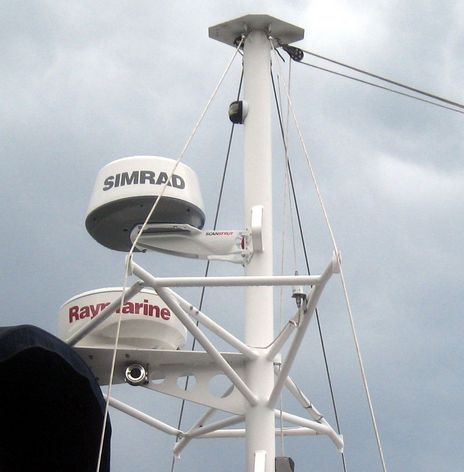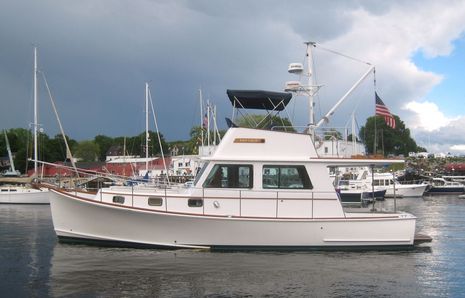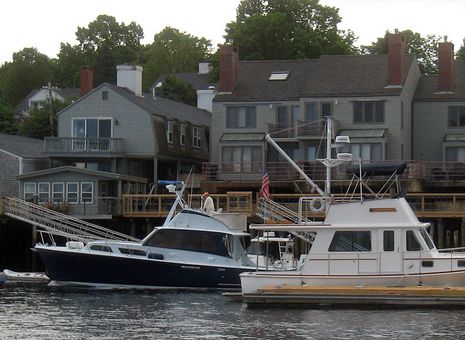4th of July 2009, & antenna questions
Here’s hoping that American panbots had a wonderful holiday weekend, and that northern hemisphere readers everywhere are enjoying the boating season. I’m pleased to report that blue skies are finally breaking out here in Maine. Friday night’s harbor fireworks were pretty sad — even those of us out in boats could only see vague glows in the fog — but there were times on the 4th that flags dried out enough to flutter. And isn’t Gizmo looking good? I still haven’t gotten around to changing the name lettering yet, but as an electronics test bed — and a cruising celebration of independence — she’s really coming along…
I had the mast folded down last week, and between rain storms, installed the two domes seen below, along with the Scanstrut mount — very easy and solid, especially given the borrow (from a friendly local boat yard) of a Marson Big Daddy Riveter. The BR24 is now cabled to a Simrad NX 45, which was as simple to set up as the HDS10. It’s lost target images within about 100 feet, presumably because it’s now about 22 feet high, but I think it would still impress Capt. Kessler around the harbor. I also tried 3, 4, and 6 mile BR ranges out on the Bay yesterday, with some success, but a better test will be when I get the Raymarine dome cabled to the C140W, and when I learn how to fine tune these scanners. (This may take a while, though, as I’m traveling much of next two weeks; more on that soon.)
Planning further down the road, note that mast cap is cleared off in preparation for a Flir M-Series thermal camera and a mixed brand pair of LED spreader lights to compare. But how can I best install all the stick antennas — VHF, AIS, WiFi, & cellular — Gizmo might want to have? I could have another aluminum top plate made with extensions to get antennas away from the camera and each other, or I could mount them 5 feet lower on those spreaders, or I could leave them off the mast altogether, using brackets on the sides of the fly bridge enclosure. And what about more places to hang flags, which a boat can’t have enough of? Your suggestions appreciated.
 Also please check out the handsome dark blue boat, below, that breezed by Gizmo when I was taking these pictures, its 4 foot array swinging. Was that skipper endangering his eyes and/or brain? Regardless, apparently I could safely mount the BR24 on the forward side of Gizmo’s fly bridge, and it might work a dite better at very close range. Anyone know of a stock mount that would handle the angle? Finally, note how I have the Airmar PB200 temporarily mounted on a 4 foot pole so its over the bimini but I can still loosen the bracket and simulate heel. A cleaner spot for wind sensors should also figure in the overall antenna plan. I’m beginning to realize that making all the antennas happy is going to be hard.
Also please check out the handsome dark blue boat, below, that breezed by Gizmo when I was taking these pictures, its 4 foot array swinging. Was that skipper endangering his eyes and/or brain? Regardless, apparently I could safely mount the BR24 on the forward side of Gizmo’s fly bridge, and it might work a dite better at very close range. Anyone know of a stock mount that would handle the angle? Finally, note how I have the Airmar PB200 temporarily mounted on a 4 foot pole so its over the bimini but I can still loosen the bracket and simulate heel. A cleaner spot for wind sensors should also figure in the overall antenna plan. I’m beginning to realize that making all the antennas happy is going to be hard.















Ben – I’d think of using Phillystran for the mast stays. It’s rf invisible and would give you plenty of space on those spreaders to mount all sorts of antennas.
Hey Ben,
It might be blog worthy to mention NMEA’s spacing requirements for different types of antennas. I think they can be a little hard to obtain in most cases, but should always be kept in mind.
On an unrelated note. Any possibility of putting up a job posting link for qualified Marine Electricians on your blog, I know that allot of people in the industry follow your blog.
Hi Ben
A combination antennas with filters like RR-electronic Pacific. This could place as many antennas as possible at the highest position.
Yachting VHF and AIS class B have common grounding with battery and antenna grounding. Have you made a plan for all different grounding of Gizmo?
After testing the BR24 I would place it no more then 6 feet above water. The performance in close ranges is fantastic. I have followed people walking on the dock with BR24 and HDS10. It is simply the best radar in harbour environments. But long-range performances are poor and it can’t start up SART, radar beacons and active radar reflectors.
Keep the Raymarine mounted high for coastal and blue water. Use the BR24 low for docking.
How much is Gizmo rolling in bad sea? Radar performance on sailing vessels improves a lot with self levelling radar mount. But I never mounted a self-levelling on an motor yacht.
Ben:
My Mainship 390 is the same configuration as your boat- extended flybridge with a mast.
One of the best things I did with this boat is install a hardtop and got rid of the mast. This gave plenty of room for the radar scanner, four whip antennas, horn, lights, and wind transducers.
One of the problems I had with the mast was the radar had to transmit through the bimini supports forward, especially running with the bow up. I wonder if your Raymarine may have that problem.
The downside is bridge clearance but it does make a good diving spot 17′ above the water.
Ben-
Re your comments about being exposed to the 4ft Radar running near you as it passed. Indeed this is NOT safe behavior and not considerate on the part of the skipper. I see this all the time in the Hiram Chittenden Locks in Seattle. The boats are down low in the lock with radar running (WHY?????) and people standing within 6ft of the antenna on the docks beside the locks, above the boats – placing the antenna at a location to directly expose the unaware public. The professional tugs are as guilty as the recreational boaters with 25 Kw units and 6ft arrays that are dangerous. The saving grace is the rotation of the antenna keeps sweeping the power around and helps reduce exposure time.
Re Preformance of the BR at long ranges – that is mostly a function of the small antenna with wide beamwidth – and two other possibilities:
1)There are TWO antennas involved – a transmit and receive, whose beams must overlap to provide a target detection. Beam shape and reflection issues at long ranges may be a problem.
2)Linear Frequency Modulation accuracy. The FM/CW radar concept is the only one that can be negatively impacted at long ranges by lack of absolute accuracy of the linear frequency modulation. ANY non-linear behavior results in distortion that will cause long range targets to blur in with increasing range.
I believe from snapshots of the BR user manual that they are likely adjusting the bandwidth of the linear frequency modulation as a function of range setting. They “chirp” less bandwidth at long ranges and more bandwidth at short ranges. There are several engineering reasons to do this -it can be done to match the range resolution of the radar to the display resolution. If you have 480 vertical pixels and are displaying 20 Nmi then each pixel is 253ft per pixel – no point in using more bandwidth – but the display may then show more “blob like” returns as a result.
Consider the following uber technical note – FM/CW radar uses Fourier Transform Analysis (Called DFT or FFT) to measure range. Lets say you design the radar to have 20ft range resolution. That would require a 512 Point FFT to create the 480 high pixel image and 10,000 ft of range extent. That is less than 3 Nmi. If the resolution is kept constant at 24Nmi you need to run an 8096 point FFT and have some way to display 8000 pixels! To keep costs low and reduce processing requirements the modulation is scaled per range setting and multiple effects can take place.
Last but not least – Navico is using a low cost printed microstrip antenna. Printed arrays are far less efficient than a waveguide array and for a given size have less available gain than a waveguide system of the same size. So long as the comparison is between two printed array systems then you have apples to apples comparison.
Thank you Ben for your good wishes, I had a great 4th of july. The rain finally stopped for that day, no fog either, as my rain drenched family reached Nantucket two days earlier passing thru each t-storm and rain cell that day (so much for “avoiding boomers”) on our last leg from Hyannis to Nantucket. Great fireworks too as the 20+ knot winds carried away the smoke making way for the next pyrotechnic to have a unobscured portion of sky behind the previous one.
For mounting antenna’s … easy answer … how about just mounting them on the rail.
As a reader, I am not interested in how well an antenna does at mast height. The taller the mast the better the performance, i get it. What interests me is how the product performs as if it was mounted on my rail, if I need better performance than that I can consider mounting it higher … but a stern mount antenna is in the sweet spot for a DIY installation which dramatically lowers the total cost of ownership and repair of any product (AIS, MOB, audio music, etc.) I might purchase in the future.
You spoke too soon. I sailed into Camden harbor last night in the pouring rain!!! Man it was cold. We left the boat (a friends) behind the Mercantile on the dock and went for beef stew! I was shocked the harbor was so empty. Still Raining today (Wednesday)
Small rant… crossing the Gulf of Maine, I saw a LOT of racing sailboats running both the Tricolor and deck lights. Why don’t people know the proper use of a Tricolor???
What’s the problem ?? After being rear-ended in one race, I have gone to keeping my deck lights on (which in my case illuminates my sails) in addition to the tricolor.
The problem is that it’s illegal, but more importantly, the purpose of lights are to identify the vessel type and direction. So if I’m on a big ship and I see you stern deck light and the tricolor white, it looks like a vessel approaching me (without running lights) or if I see the two port side red lights, I’m thinking it’s a vessel not under command.
Deck lights are fine, but what’s really frustrating for big vessel operators (and small boat sailors) is seeing lights that mean something other than the truth!
I say if you don’t know what proper lights should be shown, you shouldn’t be on the water.
Dan
I think b393 is referring to deck lites that are on spreaders pointing down and illuminate the deck, not rail level nav lights.
My experience is that the more illuminated a small vessel is, the happier the surrounding big guys are, that assumes of course that the PROPER nav lights are being displayed. Displaying a “doubled-up” set of nav lights would be improper.
Bob Etter
That’s correct .. my deck lights are up on the mast facing down at the deck. I see all sorts of boats with them, no reason little sailboats should be excluded !
Hi Ben,
We have stock parts that will allow you to mount the radar off the front of the flybridge. There are two part numbers for this, the mast mount that can be used for the BR24 (part# SM-18R) and the flybridge adapter kit (part# SM-AD-FB).
I will be in touch soon so we can get one coming to you 🙂
Best Regards,
Jason Romesburg
Seaview Radar Mounts
http://www.seaviewglobal.com